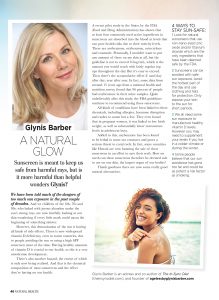We have been told much of the dangers of too much sun exposure in the past couple of decades. And we children of the 60s, 70s and 80s, who baked with joyous abandon under the sun’s strong rays, are now fearfully looking at our skin wondering if every little mark could mean the beginning of something sinister.
However, this demonisation of the sun is having all kinds of side effects
There is now widespread vitamin D deficiency, even in warm countries, due to people avoiding the sun or using a high SPF sunscreen most of the time. Having healthy amounts of vitamin D is crucial to our health, so this is a very unwelcome development.
There’s also another hazard, the extent of which is only now being realised. And that is…
The detrimental effect on our health from the chemicals in most sunscreens is now recognised
A recent pilot study in the States by the FDA (Food and Drug Administration) has shown that at least four commonly used active ingredients in sunscreens are absorbed into the blood at levels that can pose health risks due to their toxicity levels.
These are avobenzone, oxybenzone, octocrylene and ecamsule. Personally, I wouldn’t want to put any amount of these on my skin at all, but the guideline is not to exceed 0.5ng/mL, which is the amount you would reach with fairly regular top ups throughout the day. But it’s easy to exceed. Then there’s the accumulative effect if used day after day; year after year. In fact, some data from around 15 years ago from a national health and nutrition survey, found that 96 percent of people had oxybenzone in their urine samples. Quite unbelievably after this study, the FDA guidelines continue to recommend using these sunscreens.
All kinds of conditions have been linked to these chemicals
This includes allergies, hormone disruption and rashes to name but a few. They even found that in pregnant women, it was linked to low birth weight, as well as substantially lower testosterone levels in adolescent boys.
Added to this, oxybenzone has been found to be lethal to some sea creatures and poses a serious threat to coral reefs. In fact, some countries like Hawaii are now banning the sale of these unscreens in an effort to save their reefs. How on earth can these sunscreens therefore be deemed safe to use on our skin, the largest organ of our bodies?
Thank goodness there are now some really good natural alternatives.
4 ways to sun safe
- Look for natural sunscreens that use non-nano-sized zinc oxide and/or titanium dioxide which are the only ingredients that have been deemed safe by the FDA.
- Sunscreens can be avoided with safe sun exposure. Avoid the hottest part of the day and use clothing and hats for protection. Only expose your skin to the sun for short periods.
- We all need some sun exposure to manufacture healthy vitamin D levels. However you may need to supplement your levels if you live in a colder climate or during the winter.
- Some people believe that our sun avoidance has gone too far and could be as potent a risk factor as smoking.


Comments 1
Very interesting. Something I haven’t thought of before.